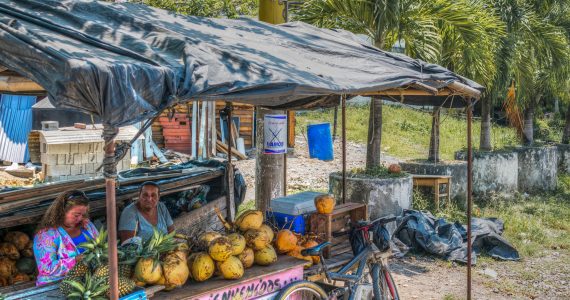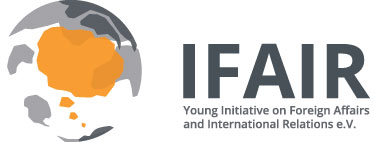
Running Away from Hunger: The food security-migration nexus in Guatemala, Honduras and El Salvador
Disclaimer: The views and opinions expressed in this article are those of the author and do not necessarily reflect the opinion of IFAIR e.V. or its members.
Notwithstanding the increased attention of scholars to human security and in particular to migration, some of its dimensions are still relatively unexplored. Reframing the current debate on migration worldwide in terms of food security can be a useful analytical tool to address one of the most pressing security challenges of the 21st century.
Guatemala, Honduras and El Salvador are among the most food insecure countries in Latina America and the Caribbean (The Economist, 2017; Chon, D’vera et al., 2017). Simultaneously, they rank among the countries which contribute the most to migration, both internally and internationally (McAuliffe & Ruhs, 2018). Not surprisingly, they are also among the most troubled countries in the region in terms of violence, poverty, economic instability and climate shocks.
Although it may seem logical to expect some sort of nexus among these factors, evidence is still scarce, and the connections remain largely unknown. Migration has indeed multiple and complex causes; however, most research focuses on violence and economic factors. Nevertheless, this is only part of the story. Since most of the traditional drivers of migration in the Northern Triangle are inevitably intertwined with the lack of food security, its analysis is crucial to understand the root causes of the migratory phenomenon.
1 The hidden links of food security: violence, poverty, economic instability and climate change
Evidence shows that most of the migrants from Guatemala, Honduras and El Salvador come from rural areas and previously worked in the agricultural sector, the primary source of employment and livelihood (WFP et al., 2017: 29). Nevertheless, according to the World Food Program’s (WFP) Food Security Index, 47% of households are either moderately or severely food insecure, with undernutrition reaching a peak of 30.5% in Guatemala. Moreover, allocation of remittances sent by previously emigrated family members mostly go into basic foodstuff and can therefore be seen as evidence for its scarcity in most households (WFP et al., 2017: 42). Indeed, food insecurity is a major concern in the Northern Triangle, and arguably presents a positive correlation with some of the most studied causes of migration: violence, poverty, economic instability and climate change.
1.1 Food security-violence nexus
An exploratory study conducted in 2016 by the Organization of American States (OAS), WFP and the London School of Economics suggests possible interplays between violence and food security. Although both dynamics have triggered mass migration in the Northern Triangle for a long time, the correlation between the two has received little attention. Rural areas in Guatemala, Honduras and El Salvador are characterized by a very limited presence of the State and this creates fertile ground for criminal gangs to control the territory. Families often lose their crops and livestock because of thefts, extortions or armed robberies (WFP et al., 2017: 41). This is particularly alarming considering that most households completely rely on these resources to make a living. Criminal groups also control the movement of vehicles and people in and out of rural areas, imposing taxes or bans on transportation of agricultural products. This results in higher prices as well as decreased availability and access to food. On the other hand, food insecurity is also a major driver of violence which itself becomes a common practice for survival. Several assaults to women receiving food-aid from the State are a case in point (Barreto & Pisani, 2016:26).
1.2 Food security- poverty nexus
Other mainstream causes of migration are identified in poverty and economic instability. In rural areas in Central America, life is largely centered around the agricultural sector. Especially there, food security, economic instability and poverty are strongly correlated. The region is characterized by high unemployment, limited and seasonal labor demands and irregular paid wages (WFP et al., 2017: 5). The budget of most households is almost entirely devoted to food and finding a job outside the agricultural sector is quite difficult. Besides, the increasing poor harvests trigger both unemployment and lack of food. To aggravate the situation, these countries are all part of the dry corridor, a geographic area characterized by irregular rainfalls that alternate prolonged droughts with tropical storms. These weather conditions have devastating effects on the region’s subsistence agriculture. Since the economy revolves around the land and most of the population heavily relies on it to survive, land degradation strongly disrupts food security and forces people to migrate.
1.3 Food security-climate change nexus
Due to the above-mentioned geographical position, Guatemala, Honduras and El Salvador are among the most environmentally vulnerable areas in the Americas. The devastating effects of the “El Niño” phenomenon in 2009, revealed the consequences of climate change in the area, further worsening the precarious conditions of rural communities (Vaqué, 2017). The increasingly frequent occurrence of extreme climate shocks deteriorates the quantity and quality of crops, making life unsustainable for many. The most striking effects of climate change are land degradation and pest infestation that lead to extremely high levels of food insecurity (Goode et al., 2018). Unable to provide enough food for themselves and their families, many peasants and farmers are left with few options but leaving their lands.
2 Legal framework and food security assessment
Migration should never be a survival strategy, but rather a voluntary choice. In the Northern Triangle, hunger is one of the main reasons that force people to leave (Silva-Nichols, 2018). Yet, Latin American countries have been at the forefront of the legal developments concerning the right to food and have made major progresses with the adoption of laws on Food Security and Nutrition (FAO 2015b). As a matter of fact, the three analyzed countries recognize either directly or indirectly the right to food (FAO n.d.). The governments of Guatemala (Art. 51) and Honduras (Art. 123) explicitly guarantee the right to adequate food in their Constitution and through several international instruments. Conversely, El Salvador recognizes the right to food only implicitly, addressing the issue from an economic point of view by stating the duty of the State to guarantee a minimum wage to live with dignity (Art. 37-38). Moreover, the three states are all party to the Universal Declaration of Human Rights, which recognizes the right to food in Art. 25, and the International Covenant on Economic, Social and Cultural Rights (ICESCR) which is the first legally-binding international treaty that recognizes the fundamental right to be free from hunger and the right to adequate food. However, the mismatch between the legal rights and the reality of everyday life is striking. Weak state structures in rural areas coupled with poor management of the resources and inefficient state policies, make it extremely difficult to guarantee and implement legal rights.
Food security is attained when food availability, access, and utilization are present and stable over time. The rural areas of the Northern Triangle do not, or only partly, satisfy these requirements: Guatemala, Honduras and El Salvador are affected by moderate or high levels of food insecurity which significantly increased due to the detrimental climate of the dry corridor (FAO, 2015a). The high susceptibility to climate change and variability, jeopardizes agricultural productivity, resulting in inadequate food availability throughout most of the year. Moreover, adequate food access remains a major issue, especially for rural communities that lack economic resources to buy food and are often victims of local gangs. In many cases, families spend up to 75% of their income on food (WFP, 2017: 51-52), thus lowering their capacity to enjoy other fundamental rights such as education. Furthermore, even those households that have an acceptable food consumption score poorly in diet quality and nutritional intake, lacking iron, proteins and vitamin A (ibid.: 50). Arguably, this chronic or seasonal condition of food insecurity prevents people from living a normal and healthy life and acts as a major driver of migration.
Conclusion
Migration has been part of human development since its very early stages and is indeed a positive force for the development of nations. Nevertheless, it must be a voluntary choice and not one forced by unbearable conditions. Unfortunately, this is not the case in the Northern Triangle, where people are forced to flee because of hunger. Although migration is a multi-layered phenomenon and cannot be reduced to one factor, the dimension of food security has been overlooked for too long. This brief analysis demonstrates that food insecurity in Central America is positively correlated with violence, economic instability, poverty and climate change and that they all ultimately act as a push factor for migration. Moreover, food security stands at the core of the phenomenon: food insecurity both causes and is caused by violence, poverty and economic instability and is exacerbated by climate shocks. Recognizing the existence of this bidirectional correlations, it is crucial to reframe the current debate on migration from Guatemala, Honduras and El Salvador by addressing its root causes. If food insecurity is one of the main push factors for leaving, the governments of these countries and the international community must recognize the need to invest in ensuring the right to food, not only as a fundamental right, but also to contribute to the security and political stability of both, the countries of origin and the hosting ones. Should the correlation between food security and other well-known causes of migration be recognized and understood, migration-related policies in Central America could contribute to a better management of the issue by taking preventive measures and minimizing negative effects. Many powerful states are so concerned with the issue of migration that their policies simply aim at containing the situation and limiting the damage. However, they do not seem to realize that instead of dealing with the consequences, it would be better to solve the problem at its origin by addressing food security issues, among others. Fostering rural sustainable development, promoting long-term investments and resilience to climate change should be a priority. This is the only way to make sure migration will finally be a choice and not a survival strategy.
References
Barrett, C. 2013: Food Security And Sociopolitical Stability. Oxford University Press.
Barreto, M.; and Pisani, M. 2016: Hunger Without Borders: The Hidden Links Between Food Insecurity, Violence And Migration In The Northern Triangle Of Central America. IOM, WFP, LSE, OAS, p. 26.
Cortes, G. 2004: Partir para quedarse: Supervivencia y cambio en las sociedades campesinas andinas de Bolivia. La Paz: Institut français d’études andines. pp. 317-376.
Chon, D’vera et al. 2017: Immigration From Guatemala, Honduras, El Salvador Up. Pew Research Center’s Hispanic Trends Project. Retrieved from https://www.pewhispanic.org/2017/12/07/rise-in-u-s-immigrants-from-el-salvador-guatemala-and-honduras-outpaces-growth-from-elsewhere/.
FAO. 2015a: Panorama de la Seguridad Alimentaria y Nutricional en Centroamérica y República Dominicana 2014. Panamá: FAO. Retrieved from http://www.fao.org/3/a-i4349s.pdf
FAO. 2015b: Análisis de la Legislación en Materia de Seguridad Alimentaria y Nutricional. Panamá: FAO. Retrieved from: http://www.fao.org/right-to-food/resources/resources-detail/en/c/395887/.
FAO, IFAD, WFP. 2014: The State of Food Insecurity in the World 2014. Strengthening the Enabling Environment for Food Security and Nutrition. Rome: FAO. Retrieved from http://www.fao.org/3/a-i4030e.pdf.
FAO n.d.: The Right to Food around the Globe: Honduras. Retrieved from: http://www.fao.org/right-to-food-around-the-globe/countries/hnd/en/.
Goode, M. et al. 2018: Driven Away From Home By Climate Change. World Food Programme Insight. Retrieved from: https://insight.wfp.org/driven-away-from-home-by-climate-change-e37a65871f36.
Lozano Sivisaca, D. et al. 2015: Eventos Climáticos Extremos Y Migración Interna En Guatemala, Un Análisis Basado En Percepciones De Expertos. CIENCIA Ergo-Sum, Vol. 22.
McAuliffe, M.; and Ruhs, M. 2018: World Migration Report 2018. International Organization For Migration (IOM) and UN Migratory Agency, pp. 75-81.
Silva-Nichols, H. 2018: The Hungry Caravan. Foreign Policy. Retrieved from https://foreignpolicy.com/2018/11/06/the-hungry-caravan-central-america-migration/.
The Economist Intelligence Unit. 2014: Food Security In Focus: Central And South America. pp. 13-14.
Vaqué, J. 2017: Chronology Of The Dry Corridor: The Impetus For Resilience In Central America . Agronoticias: Agriculture News From Latin America And The Caribbean | Food And Agriculture Organization Of The United Nations. Retrieved from: http://www.fao.org/in-action/agronoticias/detail/en/c/1024539.
WFP, OAS, IOM, IFAD, IDB. 2017: Food Security and Emigration: Why People Flee And The Impact On Family Members Left Behind In El Salvador, Guatemala And Honduras.
Zezza, A.; Carletto, C.; Davis, B.; & Winters, P. 2011: Assessing the impact of migration on food and nutrition security. Food Policy, 36(1), 1–6.

Agnese Pacciardi
Agnese Pacciardi is a MA student in International Security Studies at the Sant'Anna School of Advanced Studies and the University of Trento.
